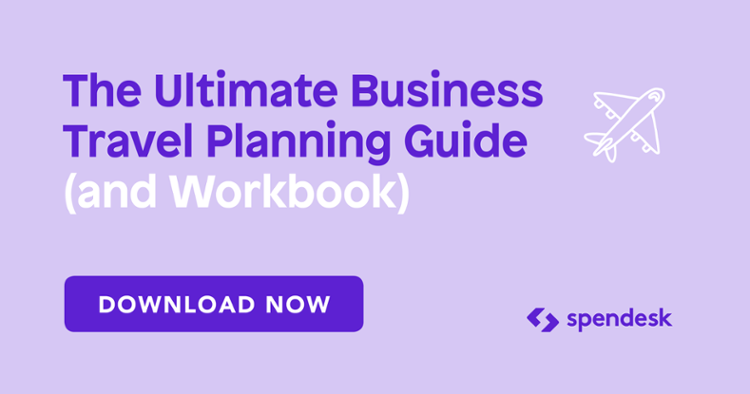How modern CFOs easily optimize travel spending

Published on March 4, 2019
)
There’s always been a certain glamour to work travel. You imagine that glorious feeling of stepping off a business class flight and checking into a classy hotel lobby before tomorrow's meeting with an important client.
But the reality is usually a little different. There’s a lot of waiting around, delayed flights, rushing from place to place, and not a lot of sleep. Plus, expense reports.
For travellers, business trips can mean serious stress. And for companies, they usually mean major spending and the chance that it doesn't pay off.
Which is why smart CFOs and managers look for ways to make travel management more effective. That means saving money while also keeping employees happy and fulfilled.
Spendesk and TravelPerk teamed up for an exclusive webinar to help finance leaders achieve these goals. And in this post we're going to look at the key takeaways from that discussion.
More travel management tips, tools and strategy:
Business travel is tough!
As we laid out in the introduction, work trips aren't always as glamorous as you'd like. For two reasons:
Employees are away from home. They don’t have their families nor the usual office support system they’re accustomed to having.
You want the best deal for the company. Which means they can't always involve business class flights and four-star hotels.
Ideally, you’d be able to have employees travelling in style without hitting the bottom line too hard. But in reality, one of these interests often wins out.
And the time and effort that you spend trying to find that balance add up as well.
So how do smart CFOs overcome these hurdles? TravelPerk explains that there are five keys to improving the process:
1. Access to low-cost inventory
The major airlines and train companies have dined out on corporate money for years. Businesses have become used to paying more than they probably should to fly.
But just because it’s “normal,” that doesn’t mean it’s best. Instead, consider using all the low cost, convenient travel options available to you.
Sites like Kayak and Opodo let you book flights, hotels, and even rental cars all from your office. And they’ll also compare prices to make sure that you get the best price possible.
Plus, new providers like AirBnb and Uber have made travel cheaper on the whole. If your current policy prohibits these vendors, you’re more likely to be overpaying for business trips.
But some companies will of course be hesitant to use these. You need to make sure that bookings meet policy, and that every payment is tracked. It’d be nice to let your team book flights with any airline, but this is too tricky to manage.
In fact, this is easily achievable with tools like TravelPerk. It pulls together travel options from a range of different providers and puts them right there on the page for you. And because it’s built for businesses, managers can still easily set limits and follow what staff are purchasing.
So basically, everybody wins.
2. An automated travel policy
Your company probably has a travel policy in place - either written down or verbal. But it’s also highly likely that team members have no idea what the policy is or how it works.
That’s a problem. Because in order to answer their questions, they either have to carefully read through (and hopefully understand) the written policy, or they have to bother their managers or the operations team.
The real issue here is that travel policies aren’t always built into booking methods. When an employee goes to Skyscanner to book, the website doesn’t know your travel policy and lets them book anything they like.
To fix this issue and still remain flexible, it pays to lean on automation. For this, you have two options:
Use spending methods that have a built-in policy. That way, employees know they’re within policy because they won’t be able to purchase otherwise.
Try a travel management tool that’s built for business. For example, TravelPerk lets your team book all their travel from a central platform using a company profile that includes your specific policy requirements.
Both are good options. It just depends on whether you want to prioritise all company spending, or focus only on travel.
3. The ability to self-book
Once you’ve automated your travel policy (as above), it becomes far easier to let employees book their own trips. And this is a good thing - it takes the pressure off your operations and finance teams, and employees actually want to book for themselves.
Again, this is a matter of making new booking options available to teams. That could mean using a consumer booking site like Kayak or Skyscanner (and carefully tracking online payments), or going with a business travel tool.
Whichever you choose, the point is to take the burden off your finance team.
4. Clearly categorised travel bookings
Aside from finding the flights and accommodation to suit travellers, the other big challenge in travel management is tracking everything. When you have team members all over the organisation booking their own trips, it can be tough to stay on top of all those payments.
It’s important to keep tabs on where your money is going. Travel spending should be categorised both by type of expense (including flights, accommodation, per diem), and also by team and purpose of the trip.
At the end of every month, quarter, and year, you want to know exactly how much your marketing team has spent to attend conferences (and the main costs associated), and how much your sales team has spent to visit clients.
If you’re using a good spend management tool, this will be built in. Every payment will have an owner, a team, and even an accounting code. So your company’s end-of-the-month reconciliation grind becomes a breeze.
5. Data-optimised travel management
This last point from TravelPerk should really sum up all the tools we use. You should always be able to see what’s working best for you, and what needs to change.
In this case, it’s about being able to clearly know what you’re spending on travel bookings, and who’s spending it. This is so valuable if you want to be able to keep your budget under control, and deliver top-notch financial services to your company.
And once again, you don’t want to have do all this analysis yourself. Using a travel or spend management tool, you’ll have every travel payment in one place, with dashboards and reports to track where all those dollars, pounds, and euros have gone.
This is how modern CFOs handle tedious tasks. They put the best tools in the hands of their teams, so that they don’t have to lose hours on something a machine can do instantly.
That’s better for everyone.
How you pay makes travel even more challenging
We touched on the importance of using good payment methods above. And this isn’t only limited to making bookings.
When your team members travel, how do they pay for things? In most companies, there are two options:
They’re one of the lucky souls who travel with a company card; or
They use their own money and then have to wait o be reimbursed.
The first option isn’t great. If you’re lucky, the traveller has their own card, so you generally know who’s been using it. But most companies share cards around. And then at the end of the month, you spend hours figuring out which payment was made by whom, and for what.
And the second option is even worse! Employees have to dig into their own money while travelling for work. Which just doesn’t seem fair. And then they have to go through the boring process of filing expense reports, which the finance team has to then go through the boring process of reviewing and approving.
There’s also the real potential for expense report fraud. You trust your team, but you can’t truly be sure that what they’re claiming is actually what they spent. Or that it was really a work-related expense.
Payment methods built for business travel
This is all a result of using payment methods that weren’t created for companies. Even the “company credit card” is really just an average credit card with a few bells and whistles.
What you want is smart, trackable spending. You want every payment to be logged against the spender, categorised by team and type, with a proof of purchase attached.
This gives you a few distinct advantages:
You can track spending in real time. Because every card is connected to one central platform, you’ll know exactly where the money goes as soon as it’s gone.
Approvals are logged. Since some employees will need a manager to sign off before buying, the tool will ask for that manager’s approval, and you’ll always have a record of this.
Every team member can have a card. Since these are not company credit cards, you don’t have anything to worry about. Each card has its own limits and daily budget, and employees can’t get carried away on the company dime.
The outcome is a way for regular employees to spend while travelling, with tracking and accounting features that make life easier for finance types.
What does this actually look like?
This approach combines a few relatively common tools in one:
Prepaid expense cards. They’re more secure than company cards, and you can have as many as you need.
Virtual cards for online spending. When a team member has Skyscanner open, they would normally pay with the company card. These virtual cards mean they don’t have to search all over the office for one, and you know exactly who made the payment.
Expense report app. Occasionally your team will be caught out without their prepaid card. These apps let them record their payments as they make them, save receipts digitally, and gives the finance team real-time visibility.
Spend tracking dashboard. The finance team needs to know how the entire company is spending its budget. Since all cards (and expense reports) are connected, you can do this easily.
Ideally, you’d find the right expense management tool that’ll combine all of these important factors. If you’re looking for ideas, here are our favourites.
Once you have the tool (and cards) in place, you’ll be able to get rid of the most tedious aspects aspects of your spending process. No more expense reports (except in abnormal circumstances), no more chasing teammates for receipts, and no more expense spreadsheets.
The small changes CFOs make - with big results
We’ve covered a range of different options above, but always with the same aim: to make the travel process smooth. While teams like to travel - many companies consider it essential - there’s still a lot of friction.
The biggest business travel issues tend to have a few key causes:
High costs that come with traditional suppliers (and avoiding lost-cost options)
An inability to trust employees to book their own trips
Classic spending methods that cause headaches for travellers and more administration for finance teams
If you can reduce (or eliminate) these blockers for both employees and the finance team, everyone’s life becomes a whole lot easier.


)
)
)